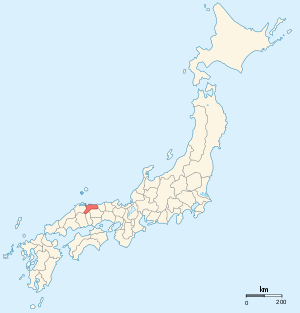Hōki Province
Hoki Province (伯耆国, Hōki no kuni) was an old province of Japan in the area that is today the western part of Tottori Prefecture.[1] It was sometimes called Hakushū (伯州). Hōki bordered on Inaba, Mimasaka, Bitchū, Bingo, and Izumo Provinces.

Map of Japanese provinces (1868) with Hoki Province highlighted

Hiroshige (1797-1858):Rice field in Hoki province
The ancient capital was in the area that is now Kurayoshi, and a major castle town was at Yonago.
Maps of Japan and Hōki Province were reformed in the 1870s when the prefecture system was introduced.[2] At the same time, the province continued to exist for some purposes. For example, Hōki is explicitly recognized in treaties in 1894 (a) between Japan and the United States and (b) between Japan and the United Kingdom.[3]
Historical districts
- Tottori Prefecture
- Aimi District (会見郡) - merged with Aseri District to become Saihaku District (西伯郡) on March 29, 1896
- Aseri District (汗入郡) - merged with Aimi District to become Saihaku District on March 29, 1896
- Hino District (日野郡)
- Kawamura District (河村郡) - merged with Kume and Yabase Districts to become Tōhaku District (東伯郡) on March 29, 1896
- Kume District (久米郡) - merged with Kawamura and Yabase Districts to become Tōhaku District on March 29, 1896
- Yabase District (八橋郡) - merged with Kawamura and Kume Districts to become Tōhaku District on March 29, 1896
gollark: OH BEE
gollark: YOU INVOKED POLITICS
gollark: OH NO
gollark: Until someone dredged them up again from the search logs.
gollark: See, if everyone stopped using them ever and they were erased from everyone's mind, they would be gone!
See also
Notes
- Nussbaum, Louis-Frédéric. (2005). "Hōki" in Japan Encyclopedia, p. 343, p. 343, at Google Books.
- Nussbaum, "Provinces and prefectures" at p. 780.
- US Department of State. (1906). A digest of international law as embodied in diplomatic discussions, treaties and other international agreements (John Bassett Moore, ed.), Vol. 5, p. 759.
References
- Nussbaum, Louis-Frédéric and Käthe Roth. (2005). Japan encyclopedia. Cambridge: Harvard University Press. ISBN 978-0-674-01753-5; OCLC 58053128
- Papinot, Edmond. (1910). Historical and Geographic Dictionary of Japan. Tokyo: Librarie Sansaisha. OCLC 77691250
External links
![]()
This article is issued from Wikipedia. The text is licensed under Creative Commons - Attribution - Sharealike. Additional terms may apply for the media files.